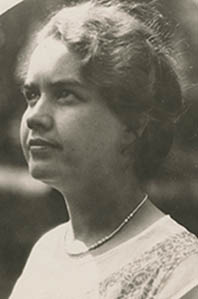Table of Contents
Student Materials from the University of Chicago
| Ask a question |
| Request a visit |
| Potentially harmful content statement |
Summary |
|
| Creator: | Sedgwick, Lillian Reynolds. |
| Title: | Lillian Reynolds Sedgwick Papers |
| Dates: | 1906-1948 |
| Size: | 3 boxes (2 linear feet) |
| Abstract: | The Lillian Reynolds Sedgwick Papers contains materials relating to her years as both a student and a professor of botany. |
| Language: | English |
| Repository: |
University Archives, Special Collections Research Center Syracuse University Libraries 222 Waverly Ave., Suite 600 Syracuse, NY 13244-2010 https://library.syracuse.edu/special-collections-research-center/university-archives |
Biography

Lillian Reynolds Sedgwick was born on December 26, 1896 in Chicago, Illinois. She received her bachelor’s, master’s, and doctorate degrees in botany from the University of Chicago, where she was a student until 1922. While studying at the University of Chicago, Sedgwick met her future husband, Paul Joseph Sedgwick. He was also a student of botany, and the two would together turn their passion for plant life and teaching into life-long careers.
In 1922, after graduating from the University of Chicago, the couple moved to Syracuse, New York and both became employed as botany professors at Syracuse University. They married two years later, on September 6, 1924 and eventually had one daughter, Joanne. Along with teaching botany at Syracuse University, Sedgwick also worked as a technical assistant at the University’s Natural History Museum in Lyman Hall and was instrumental in the installation of the campus’s first greenhouse, originally built on the quad.
Sedgwick was involved with Camp Fire, originally known as Camp Fire Girls of America, for most of her life; she first joined the organization in 1915 at the age of nineteen. The Camp Fire Girls of America taught young girls outdoor skills and engaged them in many outdoor activities, such as camping. Sedgwick taught nature and crafts and served as a camp director for the Onondaga Council of Camp Fire Girls and as a member of the organization’s board of directors. She also worked as the nature director for one of Camp Fire’s properties, Camp Talooli, in Pennellville, New York for many summers. Over the course of decades Sedgwick worked with many young girls, who affectionately nicknamed her “Miss Teeny” because of her short four-foot-ten stature. A log cabin at Camp Talooli was constructed and named Teeny Lodge in her memory.
Throughout her life Sedgwick participated in many other clubs and organizations. She was a member of the Syracuse Botanical Club, the Onondaga Primrose Society, the Syracuse University Women’s Club, the American Rock Garden Society, and the Alaska Native Plant Society. Sedgwick was also a former president of the Professional Women’s League and a member of the Center for Nature Education at Baltimore Woods in Marcellus and served on the organization’s board.
Sedgwick died on August 26, 1987, in Anchorage, Alaska.
Scope and Content Note
The Lillian Reynolds Sedgwick Papers is divided into four series: Personal Papers, Printed Materials, Student Materials from the University of Chicago, and Teaching Materials.
The Personal Papers series contains two small music books Sedgwick used as a young girl when practicing her music and a 1948 invitation to dinner hosted by the Professional Women’s League.
The Printed Materials series contains five published articles by various authors, including one article written by Sedgwick and published under her maiden name, Lillian Grace Reynolds.
The Student Materials from the University of Chicago series contains primarily handwritten notes from classes Sedgwick took while working towards her bachelor’s, master’s, and doctorate degrees in botany at the University of Chicago.
The Teaching Materials series contains assignments, notes, and other papers from Sedgwick’s career as a professor of botany at Syracuse University.
Restrictions
Access Restrictions
Please note that the collection is housed off-site, and advance notice is required to allow time to have the materials brought to the Reading Room on campus.
Use Restrictions
Written permission must be obtained from the Syracuse University Archives and all relevant rights holders before publishing quotations, excerpts or images from any materials in this collection.
Related Material
In addition to these papers, the Syracuse University Archives also holds a clippings file and a portrait file on Lillian Reynolds Sedgwick, as well as the papers of her husband and fellow botany professor, Paul Joseph Sedgwick.
Selected Search Terms
Names
Subjects
Administrative Information
Preferred Citation
Preferred citation for this material is as follows:
Lillian Reynolds Sedgwick Papers,
University Archives,
Special Collections Research Center
Syracuse University Libraries
Acquisition Information
The materials in the Lillian Reynolds Sedgwick Papers were donated to the Archives by her daughter, Joanne Sedgwick, in 2009.
Processing Information
The materials have been processed and placed in acid-free folders and boxes.
Finding Aid Information
Created by: Steffi Chappell
Date: 2014
Revision history:
Inventory
| Personal Papers | |||||||||||
| Box 1 | Musical Compositions and Exercises 1906, 1909-1910 | ||||||||||
| Box 1 | Professional Women’s League Dinner Invitation 1948 | ||||||||||

